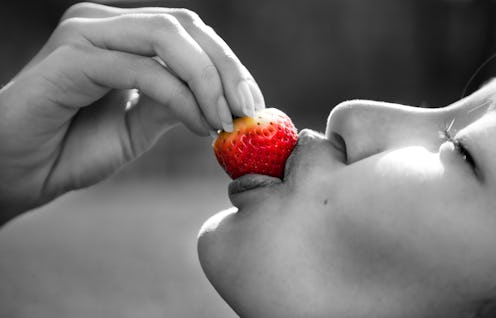Life
The Science Behind Valentine's Day Aphrodisiacs

This Valentine's Day, scores of Casanovas across the globe will strategically indulge in well-known aphrodisiacs in hopes of jumpstarting their libidos before the scented candles burn out — but do aphrodisiacs actually work? Whether you're of the mind to subscribe to or scoff at canned romance, you have to admit, you're secretly fascinated by the idea of holistic arousal and wonder if there's scientific validation behind the age-old Marvin Gaye-inducing effects of oysters and champagne. Well Romeo, you're in luck, because I was wondering the same — precisely why I took to the mean streets of Google to satiate my voracious appetite for useless knowledge.
And what did I find out? Well, it's no surprise that the word aphrodisiac dates back to the ancient Greeks — named after Aphrodite, the Greek goddess of love, beauty, and pleasure. And it's really no surprise that we've been trying to improve the ways in which we get it on ever since. In fact, common household aphrodisiac applications can be traced back to Ancient Egypt, where Cleopatra allegedly fortified her bathwater with saffron to increase genital sensitivity. Fast forward more than a thousand years to find Montezuma, infamous leader of the Aztec Empire, who reportedly insisted on drinking frothy dark chocolate daily so he could "better satisfy his numerous wives."
As time went on and stories were passed down, the list of accessible aphrodisiacs continued to grow exponentially, and today that extensive list includes everything from oysters and champagne to asparagus, blowfish, blueberries, cherries, cheese, cinnamon, strawberries, ginger, garlic, and figs. At this point you're probably thinking, cool story and all, but... Do they work? And what are they doing to my brain and body?
According to Dr. Dolores J. Lamb, Director of Baylor College's Center for Reproductive Medicine, many aphrodisiac foods contain substances that improve circulation in the body and heighten serotonin in the brain, which inevitably improves overall health and physical fitness. It doesn't take a reproductive scientist to deduce that better health can lead to better sex. But unfortunately, although the high zinc levels in an oyster will stimulate blood flow, you would have to eat an entire beach to experience a direct and immediate impact on sexual arousal. In sum, the science supporting the efficacy of aphrodisiacs is very weak, and as Lamb comically points out, "... that should be fairly obvious given that no one is making millions off their fig tree harvest."
OK, I can accept the lack of scientific evidence backing up the seductive powers of a raw bivalve mollusk floating in a pool of Tabasco and lemon, but this newfound knowledge begs yet another question... Why has this sexy myth persisted for centuries?
Some sociologists argue that it may be the shape, texture, and sensation associated with certain foods that trigger sexual thoughts. Great, let's try it out. Envision the shape of a banana... and now an oyster. Now recall the texture of a peach. Imagine the tingling sensation of a spicy pepper on your lips. Aroused? And just think, these foods have been readily accessible in most parts of the world for hundreds of years. So while there's still no direct scientific correlation between aphrodisiacs and sexual prowess, it's safe to conclude that our sexual associations and triggers have grown so strong that we've happily convinced ourselves that a bottle of Prosecco and a few chocolate-covered strawberries will undoubtedly lead to a night of mind-blowing orgasms. My scientific hypothesis? Placebo effect, shmacebo effect. Aphrodisiacs are fun, so in the spirit of science and Saint Valentine, let's keep trying to prove their merit.